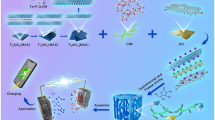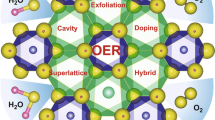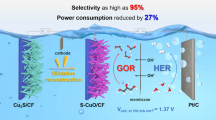Abstract
A facile method was developed to fabricate nitrogen-doped graphene microtubes (N-GMT) with ultra-thin walls of 1–4 nm and large inner voids of 1–2 μm. The successful introduction of nitrogen dopants afforded N-GMT more active sites for significantly enhanced hydrogen evolution reaction (HER) activity, achieving a current density of 10 mA·cm–2 at overpotentials of 0.464 and 0.426 V vs. RHE in 0.1 and 6 M KOH solution, respectively. This HER performance surpassed that of the best metal-free catalyst reported in basic solution, further illustrating the great potential of N-GMT as an efficient HER catalyst for real applications in water splitting and chlor-alkali processes.

Similar content being viewed by others
References
Dresselhaus, M. S.; Thomas, I. L. Alternative energy technologies. Nature 2001, 414, 332–337.
Turner, J. A. Sustainable hydrogen production. Science 2004, 305, 972–974.
Wang, X. C.; Maeda, K.; Thomas, A.; Takanabe, K.; Xin, G.; Carlsson, J. M.; Domen, K.; Antonietti, M. A metal-free polymeric photocatalyst for hydrogen production from water under visible light. Nat. Mater. 2009, 8, 76–80.
Vrubel, H.; Hu, X. L. Molybdenum boride and carbide catalyze hydrogen evolution in both acidic and basic solutions. Angew. Chem., Int. Ed. 2012, 51, 12703–12706.
Chang, K.; Mei, Z. W.; Wang, T.; Kang, Q.; Ouyang, S. X.; Ye, J. H. MoS2/graphene cocatalyst for efficient photocatalytic H2 evolution under visible light irradiation. ACS Nano 2014, 8, 7078–7087.
Fellinger, T.-P.; Su, D. S.; Engenhorst, M.; Gautam, D.; Schlögl, R.; Antonietti, M. Thermolytic synthesis of graphitic boron carbon nitride from an ionic liquid precursor: Mechanism, structure analysis and electronic properties. J. Mater. Chem. 2012, 22, 23996–24005.
Shalom, M.; Inal, S.; Fettkenhauer, C.; Neher, D.; Antonietti, M. Improving carbon nitride photocatalysis by supramolecular preorganization of monomers. J. Am. Chem. Soc. 2013, 135, 7118–7121.
Zheng, Y.; Jiao, Y.; Zhu, Y. H.; Li, L. H.; Han, Y.; Chen, Y.; Du, A. J.; Jaroniec, M.; Qiao, S. Z. Hydrogen evolution by a metal-free electrocatalyst. Nat. Commun. 2014, 5, 3783.
Ge, J. M.; Zhang, B.; Lv, L. B.; Wang, H. H.; Ye, T. N.; Wei, X.; Su, J.; Wang, K. X.; Li, X. H.; Chen, J. S. Constructing holey graphene monoliths via supramolecular assembly: Enriching nitrogen heteroatoms up to the theoretical limit for hydrogen evolution reaction. Nano Energy 2015, 15, 567–575.
Zheng, Y.; Jiao, Y.; Li, L. H.; Xing, T.; Chen, Y.; Jaroniec, M.; Qiao, S. Z. Toward design of synergistically active carbon-based catalysts for electrocatalytic hydrogen evolution. ACS Nano 2014, 8, 5290–5296.
Zheng, Y.; Jiao, Y.; Ge, L.; Jaroniec, M.; Qiao, S. Z. Two-step boron and nitrogen doping in graphene for enhanced synergistic catalysis. Angew. Chem., Int. Ed. 2013, 52, 3110–3116.
Li, X. H.; Antonietti, M. Polycondensation of boron- and nitrogen-codoped holey graphene monoliths from molecules: Carbocatalysts for selective oxidation. Angew. Chem., Int. Ed. 2013, 52, 4572–4576.
Lv, L. B.; Cui, T. L.; Zhang, B.; Wang, H. H.; Li, X. H.; Chen, J. S. Wrinkled graphene monoliths as superabsorbing building blocks for superhydrophobic and superhydrophilic surfaces (Angew. Chem. Int. Ed. 50/2015). Angew. Chem., Int. Ed. 2015, 54, 15299.
Gopalakrishnan, D.; Damien, D.; Shaijumon, M. M. MoS2 quantum dot-interspersed exfoliated MoS2 nanosheets. ACS Nano 2014, 8, 5297–5303.
Li, X. H.; Kurasch, S.; Kaiser, U.; Antonietti, M. Synthesis of monolayer-patched graphene from glucose. Angew. Chem., Int. Ed. 2012, 51, 9689–9692.
Zhang, C. Z.; Hao, R.; Liao, H. B.; Hou, Y. L. Synthesis of amino-functionalized graphene as metal-free catalyst and exploration of the roles of various nitrogen states in oxygen reduction reaction. Nano Energy 2013, 2, 88–97.
Zhao, Y.; Nakamura, R.; Kamiya, K.; Nakanishi, S.; Hashimoto, K. Nitrogen-doped carbon nanomaterials as non-metal electrocatalysts for water oxidation. Nat. Commun. 2013, 4, 2390.
Yang, W.; Fellinger, T.-P.; Antonietti, M. Efficient metalfree oxygen reduction in alkaline medium on high-surfacearea mesoporous nitrogen-doped carbons made from ionic liquids and nucleobases. J. Am. Chem. Soc. 2011, 133, 206–209.
Zhang, J.; Wang, R.; Liu, E. Z.; Gao, X. F.; Sun, Z. H.; Xiao, F. S.; Girgsdies, F.; Su, D. S. Spherical structures composed of multiwalled carbon nanotubes: Formation mechanism and catalytic performance. Angew. Chem., Int. Ed. 2012, 51, 7581–7585.
Zhu, Y. W.; Murali, S.; Stoller, M. D.; Ganesh, K. J.; Cai, W. W.; Ferreira, P. J.; Pirkle, A.; Wallace, R. M.; Cychosz, K. A.; Thommes, M. et al. Carbon-based supercapacitors produced by activation of graphene. Science 2011, 332, 1537–1541.
Ye, T. N.; Lv, L. B.; Li, X. H.; Xu, M.; Chen, J. S. Strongly veined carbon nanoleaves as a highly efficient metal-free electrocatalyst. Angew. Chem., Int. Ed. 2014, 53, 6905–6909.
Xing, Z. C.; Tian, J. Q.; Liu, Q.; Asiri, A. M.; Jiang, P.; Sun, X. P. Holey graphene nanosheets: Large-scale rapid preparation and their application toward highly-effective water cleaning. Nanoscale 2014, 6, 11659–11663.
Zhang, P. F.; Qiao, Z.-A.; Zhang, Z. Y.; Wan, S.; Dai, S. Mesoporous graphene-like carbon sheet: High-power supercapacitor and outstanding catalyst support. J. Mater. Chem. A 2014, 2, 12262–12269.
Li, Y. G.; Zhou, W.; Wang, H. L.; Xie, L. M.; Liang, Y. Y.; Wei, F.; Idrobo, J.-C.; Pennycook, S. J.; Dai, H. J. An oxygen reduction electrocatalyst based on carbon nanotube-graphene complexes. Nat. Nanotechnol. 2012, 7, 394–400.
Hu, J. Q.; Bando, Y.; Xu, F. F.; Li, Y. B.; Zhan, J. H.; Xu, J. Y.; Golberg, D. Growth and field-emission properties of crystalline, thin-walled carbon microtubes. Adv. Mater. 2004, 16, 153–156.
Sheng, Z.-H.; Shao, L.; Chen, J.-J.; Bao, W.-J.; Wang, F.-B.; Xia, X.-H. Catalyst-free synthesis of nitrogen-doped graphene via thermal annealing graphite oxide with melamine and its excellent electrocatalysis. ACS Nano 2011, 5, 4350–4358.
Futaba, D. N.; Hata, K.; Yamada, T.; Hiraoka, T.; Hayamizu, Y.; Kakudate, Y.; Tanaike, O.; Hatori, H.; Yumura, M.; Iijima, S. Shape-engineerable and highly densely packed single-walled carbon nanotubes and their application as super-capacitor electrodes. Nat. Mater. 2006, 5, 987–994.
Wang, W.; Kumta, P. N. Nanostructured hybrid silicon/ carbon nanotube heterostructures: Reversible high-capacity lithium-ion anodes. ACS Nano 2010, 4, 2233–2241.
Wick, P.; Louw-Gaume, A. E.; Kucki, M.; Krug, H. F.; Kostarelos, K.; Fadeel, B.; Dawson, K. A.; Salvati, A.; Vá zquez, E.; Ballerini, L. et al. Classification framework for graphene-based materials. Angew. Chem., Int. Ed. 2014, 53, 7714–7718.
Mecklenburg, M.; Schuchardt, A.; Mishra, Y. K.; Kaps, S.; Adelung, R.; Lotnyk, A.; Kienle, L.; Schulte, K. Aerographite: Ultra lightweight, flexible nanowall, carbon microtube material with outstanding mechanical performance. Adv. Mater. 2012, 24, 3486–3490.
Meduri, P.; Kim, J. H.; Russell, H. B.; Jasinski, J.; Sumanasekera, G. U.; Sunkara, M. K. Thin-walled carbon microtubes as high-capacity and high-rate anodes in lithiumion batteries. J. Phys. Chem. C 2010, 114, 10621–10627.
Wen, G. W.; Yu, H. M.; Huang, X. X. Synthesis of carbon microtube buckypaper by a gas pressure enhanced chemical vapor deposition method. Carbon 2011, 49, 4067–4069.
Gong, K. P.; Du, F.; Xia, Z. H.; Durstock, M.; Dai, L. M. Nitrogen-doped carbon nanotube arrays with high electrocatalytic activity for oxygen reduction. Science 2009, 323, 760–764.
Gao, M. R.; Cao, X.; Gao, Q.; Xu, Y. F.; Zheng, Y.-R.; Jiang, J.; Yu, S. H. Nitrogen-doped graphene supported CoSe2 nanobelt composite catalyst for efficient water oxidation. ACS Nano 2014, 8, 3970–3978.
Unger, K. Structure of porous adsorbents. Angew. Chem., Int. Ed. 1972, 11, 267–278.
Dinh, C.-T.; Seo, Y.; Nguyen, T.-D.; Kleitz, F.; Do, T.-O. Controlled synthesis of titanate nanodisks as versatile building blocks for the design of hybrid nanostructures. Angew. Chem., Int. Ed. 2012, 51, 6608–6612.
Wang, L. F.; Yang, R. T.; Sun, C. L. Graphene and other carbon sorbents for selective adsorption of thiophene from liquid fuel. AIChE J. 2013, 59, 29–32.
Moussallem, I.; Jörissen, J.; Kunz, U.; Pinnow, S.; Turek, T. Chlor-alkali electrolysis with oxygen depolarized cathodes: History, present status and future prospects. J. Appl. Electrochem. 2008, 38, 1177–1194.
Li, Y. G.; Wang, H. L.; Xie, L. M.; Liang, Y. Y.; Hong, G. S.; Dai, H. J. MoS2 nanoparticles grown on graphene: An advanced catalyst for the hydrogen evolution reaction. J. Am. Chem. Soc. 2011, 133, 7296–7299.
Ma, T. Y.; Dai, S.; Jaroniec, M.; Qiao, S. Z. Graphitic carbon nitride nanosheet-carbon nanotube three-dimensional porous composites as high-performance oxygen evolution electrocatalysts. Angew. Chem., Int. Ed. 2014, 53, 7281–7285.
Zhang, S.; Kang, P.; Ubnoske, S.; Brennaman, M. K.; Song, N.; House, R. L.; Glass, J. T.; Meyer, T. J. Polyethylenimine-enhanced electrocatalytic reduction of CO2 to formate at nitrogen-doped carbon nanomaterials. J. Am. Chem. Soc. 2014, 136, 7845–7848.
Jaramillo, T. F.; Jørgensen, K. P.; Bonde, J.; Nielsen, J. H.; Horch, S.; Chorkendorff, I. Identification of active edge sites for electrochemical H2 evolution from MoS2 nanocatalysts. Science 2007, 317, 100–102.
Ge, J.; Cheng, G. H.; Chen, L. W. Transparent and flexible electrodes and supercapacitors using polyaniline/single-walled carbon nanotube composite thin films. Nanoscale 2011, 3, 3084–3088.
Author information
Authors and Affiliations
Corresponding authors
Electronic supplementary material
Rights and permissions
About this article
Cite this article
Zhang, B., Wang, HH., Su, H. et al. Nitrogen-doped graphene microtubes with opened inner voids: Highly efficient metal-free electrocatalysts for alkaline hydrogen evolution reaction. Nano Res. 9, 2606–2615 (2016). https://doi.org/10.1007/s12274-016-1147-1
Received:
Revised:
Accepted:
Published:
Issue Date:
DOI: https://doi.org/10.1007/s12274-016-1147-1




